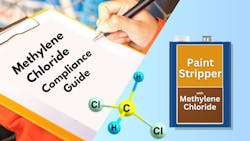EPA Publishes Compliance Guide on Methylene Chloride
Sept. 9, 2024
4 min read
The EPA is busy. Directing its limited resources to prepare helpful "how-to" guidance documents is appreciated.
On July 10, 2024, the U.S. Environmental Protection Agency (EPA) published a compliance guide for its final methylene chloride risk management rule issued under the Toxic Substances Control Act (TSCA). The final rule is complicated, and the compliance guide is a useful document for stakeholders to consider reading. A summary follows.
Background
The EPA issued on May 8, 2024, a final rule to address the unreasonable risk of injury to health that the EPA identified as caused by methylene chloride under its conditions of use (COU). The EPA believes the final rule’s measures will help prevent serious illness and death associated with uncontrolled exposures both by preventing consumer access to methylene chloride and by restricting its industrial and commercial use.
The rule allows for a reasonable transition period where industrial and commercial use of methylene chloride is prohibited, and provides a time-limited exemption for a critical or essential use for which no technically and economically feasible safer alternative is available. The rule’s measures also are intended to protect workers from the unreasonable risk of methylene chloride while on the job. The final rule took effect July 8, 2024.
Compliance Guide
According to the EPA, the compliance guide is intended to help entities understand the final rule’s requirements and the roles and responsibilities of entities subject to the rule. The 43-page guide provides details on prohibitions and associated compliance timeframes, as well as information on the Workplace Chemical Protection Program (WCPP), recordkeeping requirements, downstream notifications and other requirements applicable to entities that may continue use with strict workplace controls.
The EPA states that the compliance guide is useful for entities that manufacture, including import, process, distribute in commerce, use or dispose of methylene chloride or products containing methylene chloride. This includes use in laboratory settings. The EPA notes that the compliance guide includes special attention to the interests and needs of small businesses.
The guide is especially useful in explaining the rule’s provisions for the final rule’s WCPP component. This section will likely inspire the most questions. The guide also provides helpful information on recordkeeping requirements and downstream notification obligations.
In the guide, the EPA suggests that potentially exposed persons, such as workers and others in the workplace, “may also want to refer to the compliance guide to understand the risks from methylene chloride exposure and protections that are required in the workplace.” The guide will also be beneficial to consumers, community members or anyone else who may be affected by exposure to methylene chloride.
Discussion
The regulated community should be pleased that the EPA issued the compliance guide. We should commend the agency for developing a thoughtful document that is easy to understand and will aid readers when implementing the underlying regulation’s requirements. The EPA is busy and directing its limited resources to preparing helpful “how-to” guidance documents is appreciated.
An area that caught our eye relates to the EPA’s “An Alternatives Assessment for Use of Methylene Chloride.” The EPA cites this document in the compliance guide and states “When considering a substitute, compare the potential risks of the substitute to those of methylene chloride. … Effective substitutes reduce the potential for harmful effects and do not create new risks.”
Concerns that come to mind with the EPA’s identified alternatives are twofold.
First, many of the identified alternatives have hazard concerns comparable to those of methylene chloride. For example, the listed alternatives for adhesive removers, a prohibited use under the final regulation, include benzene and ethyl benzene. The EPA ranked these substances as highly hazardous for carcinogenicity, genotoxicity/mutagenicity and reproductive toxicity. These substances were also on the EPA’s list of 15 substances it considered for prioritization but did not select. However, these substances were included in the EPA’s proposed TSCA Section 8(d) rule requiring manufacturers (including importers) to submit copies and lists of certain unpublished health and safety studies to the EPA.
Second, the EPA’s evaluation of new chemical substance notifications submitted under TSCA Section 5 takes on average, more than a year before a risk determination is issued and an additional two years before the EPA promulgates rules to allow distribution in commerce. We mention these concerns because of the potential for regrettable substitution with existing chemical substances and the likely reality that alternatives approved under TSCA Section 5 will not be available for those prohibited uses or for uses where compliance with the WCPP is not possible.
Readers are urged to review the guidance document if they need to comply with the final TSCA Section 6 risk management rule. Certain provisions in the rule are not completely clear, and the guidance provides useful direction from the EPA.
About the Author
Lynn L. Bergeson, Compliance Advisor columnist
LYNN L. BERGESON is managing director of Bergeson & Campbell, P.C., a Washington, D.C.-based law firm that concentrates on conventional, biobased, and nanoscale chemical industry issues. She served as chair of the American Bar Association Section of Environment, Energy, and Resources (2005-2006). The views expressed herein are solely those of the author. This column is not intended to provide, nor should be construed as, legal advice.
Sign up for our eNewsletters
Get the latest news and updates
Sponsored

